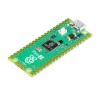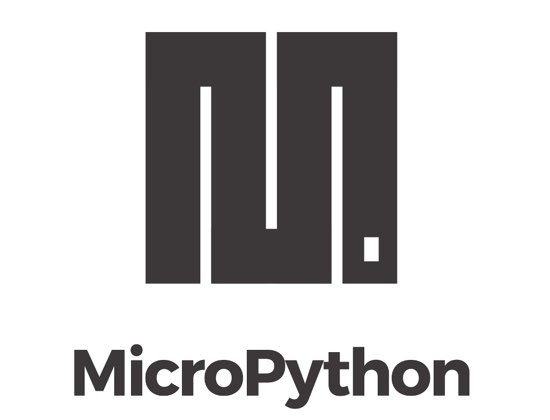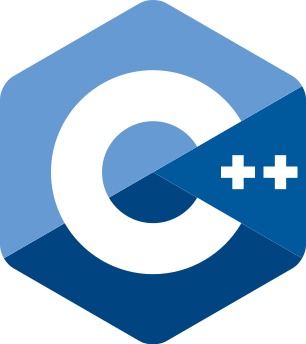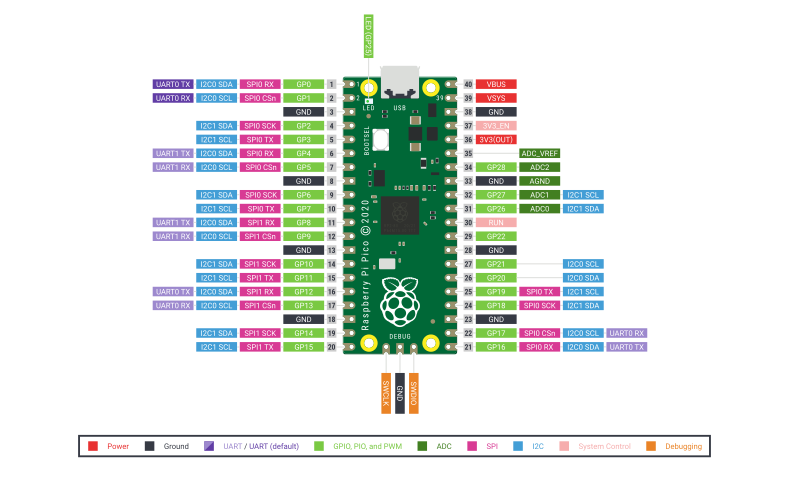




zł19.92 tax excl.
Raspberry Pi Pico 2, based on the RP2350 microcontroller, using the application and functional applications of the Cortex M33 and RISC-V cores, doubled SRAM memory and advanced security function, including Arm TrustZone. It is hardware and software with a connected model, which provides an attractive operation for enthusiasts and specialists in systems used
Raspberry Pi Pico 2 is a development board based on the RP2350 microcontroller, designed with high performance and security in mind. Compared to the previous version, Pi Pico 2 is characterized by the use of Cortex M33 cores with a higher clock speed, two additional RISC-V cores, doubling the SRAM and memory. In addition, the second version of the iconic board introduces new security features and improved interface capabilities. Raspberry Pi Pico 2 offers a significant increase in performance and functionality while maintaining hardware and software compatibility with earlier models of the Raspberry Pi Pico series.
The RP2350 system offers advanced security features based on Arm TrustZone for Cortex-M technology, including digitally signed boot, 8 KB of OTP antifuse memory for storing keys, SHA-256 acceleration, a hardware TRNG random number generator and fast error detectors. These features, along with the secure boot ROM, are well documented and available to all users, allowing professionals to seamlessly integrate the RP2350 and Raspberry Pi Pico 2 into their projects.

Kamami is the official distributor of Raspberry Pi minicomputers and dedicated accessories.
| Raspberry Pi Pico | Raspberry Pi Pico 2 | |
|---|---|---|
| Microcontroller | RP2040 | RP2350 |
| Core | 2 x ARM Cortex M0+ 133 MHz |
2 x ARM Cortex M33 150 MHz 2 x RISC-V Hazard3 |
| RAM | 256 kB | 520 kB |
| Flash | 2 MB | 4 MB |
| Communication interfaces |
2 x SPI 2 x I2C 2 x UART 3 x 12-bit ADC 16 kanałów PWM 8 x PIO |
2 x SPI 2 x I2C 2 x UART 3 x 12-bit ADC 24 kanały PWM 12 x PIO |
| Programmer interface | USB 1.1 / SWD | USB 1.1 / SWD |
| Security features | - |
Arm TrustZone for Cortex-M Digitally signed boot |
| Supply voltage | 1,8 – 5,5 V | 1,8 – 5,5 V |
| Dimensions | 51 x 21 mm | 51 x 21 mm |

MicroPython is a special version of the Python 3 programming language, prepared to run directly on embedded systems such as the Raspberry Pi Pico. The version prepared especially for the RP2350 microcontroller, supports REPL, an interactive shell that allows you to execute scripts, typing into the console and viewing the results of the program in it. Thanks to this technology, it is also possible to save the program in flash memory.
To facilitate the programming of the RP2350 microcontroller in C / C ++, the Raspberry Pi Foundation has prepared an official SDK toolkit that can be integrated with popular IDEs such as Visual Studio Code or Eclipse. The entire environment configuration process is described in the Getting started with Raspberry Pi Pico document.


The Raspberry Pi Pico can be programmed via the USB interface, it can be done in two ways.
The first is the USB mass storage mode, to program the board in this way, press and hold the BOOTSEL button, and then connect the board to the computer with a USB cable. The device will be recognized as mass memory to which you can upload the program in the same way as copying files to a pendrive. After uploading the program, the microcontroller will automatically reset and start the uploaded program. This method is suitable for uploading programs written in C / C ++ or for uploading the MicroPython interpreter.
The second way works only with programs written in MicroPython and requires prior loading of the interpreter using the first method. This method consists in saving the program layout transferred with REPL in the memory.
When programming in C/C++, there is often a need to repeatedly test the program. Loading a program via USB requires repeating the procedure every time, disconnecting the board from the computer, pressing the button and connecting the board, and then finding the compiled program and copying it to memory. The whole thing takes quite a long time, but fortunately it can be simplified using an external programmer with SWD interface. Programming via SWD is much faster, you only need to connect the programmer once with a 3-pin connector and power supply e.g. via USB and you can upload programs directly from the IDE. In addition, you can debug the program in this way and efficiently find any errors in the code by running it line by line.
Warning!
The Raspberry Pi Pico board does not include goldpin connectors and a microUSB cable. Our offer includes connectors for GPIO 1x40 (they can be easily divided into two 1x20 connectors) and a connector 1x3 for a programmer. There are also ready-made kits containing connectors and microUSB cable.

Data sheet
Manufacturer BTC Korporacja sp. z o. o. Lwowska 5 05-120 Legionowo Poland sprzedaz@kamami.pl 22 767 36 20
Responsible person BTC Korporacja sp. z o. o. Lwowska 5 05-120 Legionowo Poland sprzedaz@kamami.pl 22 767 36 20
Universal board equipped with a metalized hole grid with a pitch of 2.54 mm, enabling mounting using goldpin strips or directly on the surface, with markings facilitating the identification of signals
This modern development board features a dual-core Cortex-M33 microcontroller clocked at 150 MHz, 520 KB of RAM, and 8 MB of QSPI Flash. It features a rich set of interfaces, including I2C, SPI, UART, 24 PWM channels, and an HSTX port for high-speed differential data transfer. The board features a STEMMA QT connector, a built-in 200 mA+ LiPo charger, a USB-C port with a UF2 bootloader, and NeoPixel LEDs and a red LED for signaling. The Feather RP2350 is compatible with MicroPython, CircuitPython, Arduino, and C/C++. Adafruit 6000
A module for building a mechanical keyboard with 16 buttons and backlight. Based on the RP2040 chip, it has sockets compatible with Cherry-MX switches. Pimoroni PIM567
No product available!
A module based on the RP2040 microcontroller that lets you build your own two-player arcade controller, supporting up to 30 buttons and two joysticks. When connected via USB-C, it is automatically detected as a standard game controller on PC, Mac and Linux. With DuPont, Qw/ST connectors and support for backlit Plasma buttons, assembly and expansion are quick and solderless. Pimoroni PIM741
Board with the RP2040 microcontroller equipped with two ARM Cortex-M0+ cores and a 5x5 RGB LED matrix. There is also 2 MB of QSPI flash memory on the board. The circuit can be programmed in C/C++ or MicroPython. Waveshare RP2040-Matrix
Development kit with RP2040 microcontroller equipped with two ARM Cortex-M0 + cores that work at 133 MHz, 264 kB RAM. The board has a QVGA camera, LCD display, IMU system and a microphone. ArduCAM B0302
No product available!
The RP2040 microcontroller board features two ARM Cortex-M0+ cores running at 133 MHz, 264 kB of RAM. The board also features 2 MB of QSPI flash memory and an FPC connector. The chip can be programmed in C/C++ or MicroPython. Waveshare RP2040-Tiny
Pimoroni Pico LiPo 2 XL W PIM776 is an extended development board with the RP2350B, offering Wi-Fi and Bluetooth connectivity, 16 MB of flash memory and 8 MB of PSRAM. Thanks to its 40 GPIO pins, integrated LiPo charging system and numerous interfaces, it works well in advanced IoT projects and battery-powered systems.
This RP2040-based evaluation board features an embedded W5500 Ethernet controller, providing hardware-based TCP/IP support without burdening the microcontroller. Its compact design, PoE support, and Raspberry Pi Pico-compatible interfaces make it ideal for IoT, automation, and networking projects. WIZnet W5500-EVB-Pico-POE
No product available!
Arduino development board with RP2040 microcontroller. Equipped with WiFi and Bluetooth module, 6-axis IMU system with accelerometer and gyroscope, MEMS microphone, RGB LED diode and cryptographic system. Arduino ABX00053
The board with the RP2040 microcontroller equipped with two ARM Cortex-M0+ cores, which work at a frequency of 133 MHz, 256 kB RAM. The board also has 8 MB of QSPI flash memory. The system can be programmed in C/C++ or MicroPython. Adafruit 4884
The board with the RP2040 microcontroller in the form of a USB dongle. Equipped with Stemma QT connector, RGB NeoPixel diode, boot and reset button. Adafruit 5056
The board with the RP2040 microcontroller equipped with two ARM Cortex-M0 + cores operating at 133 MHz, 256 kB RAM. The board also has 16 MB of QSPI flash memory. The system can be programmed in C/C++ or microPython. SparkFun DEV-18288
RP2350-Touch-AMOLED-1.43 is a high-performance platform for building modern user interfaces in mobile, wearable, and control system projects. The high-contrast AMOLED display and capacitive touch, combined with an IMU sensor and RTC, provide a comprehensive development environment for applications requiring advanced interaction and mobility.
The board with the RP2040 microcontroller equipped with two ARM Cortex-M0+ cores, which work at a frequency of 133 MHz, 264 kB RAM. The board also has 8 MB of QSPI flash memory. The circuit can be programmed in C/C++, CircuitPython or MicroPython. Adafruit 4900
No product available!
Camera adapter based on Raspberry RP2040, dedicated to TinyML development. is equipped with a 2.4-inch LCD screen, microphone, camera connectors and an IMU module. It allows you to take photos, use WiFi, SD card and USB mass storage. ArduCam B0432
RP2350-Touch-LCD-1.69 is a compact and versatile development board offering advanced processing capabilities thanks to its dual-core CPU architecture and large Flash memory. The integrated touchscreen, sensors, and battery power support make it an ideal choice for HMI projects, wearable electronics, measurement systems, and educational solutions based on the RP2350.

Raspberry Pi Pico 2, based on the RP2350 microcontroller, using the application and functional applications of the Cortex M33 and RISC-V cores, doubled SRAM memory and advanced security function, including Arm TrustZone. It is hardware and software with a connected model, which provides an attractive operation for enthusiasts and specialists in systems used
